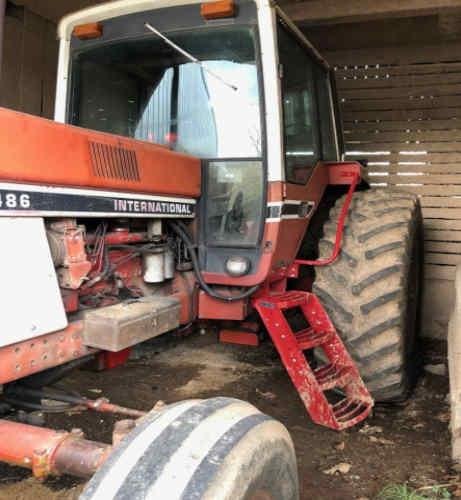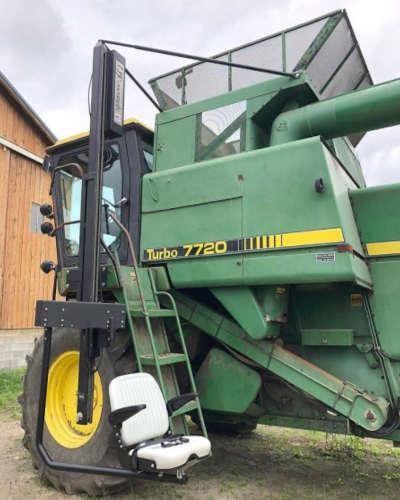Improve independence and safety when accessing agricultural equipment. Is a disability or health condition impacting your ability to access your agricultural equipment?
One of the most common reasons farmers contact AgrAbility is due to difficulty accessing a tractor, combine, skid steer or other equipment on the farm. Arthritis, spinal cord injuries, amputations, back or joint injuries and pain, and general symptoms of aging and loss of strength can impact the ability of a farmer to safely access their equipment.
Several modification options – steps, handrails, and lifts – are available for most agricultural equipment to improve access and safety.
Before deciding how to modify your equipment, it is important to determine what equipment to modify. Some equipment may not be a good choice for modifications. Modifying an antique tractor or a skid steer that is regularly in the shop for repairs might not be the best option. Consider the following:
- Ease of operation
- Frequency and Type of Use
- Age and Condition of Equipment
- Current Safety Features.
Equipment in good, safe working order is an ideal candidate for modifications and improvements. Some equipment may not be a good candidate for modifications and a newer piece of equipment may need to be obtained. When purchasing new equipment, look at a make and model that already has good accessibility. However, a piece of equipment in good and safe working condition can often be a good candidate for modification.
Modifying Your Equipment

Steps
Ergonomic steps sometimes called safety steps are often a great improvement over the original steps and typically include 3-4 wide steps with good tread and correct spacing. For tractors that already have ergonomic steps, an extra step can often be added to decrease the height of the first step.
Handrails
Handrails often mounted on the steps, door, or fender can add stable hand holds to aid in accessing equipment. When adding handrails, be sure they are correctly and securely mounted. Individuals who find themselves gripping onto the steering wheel for access should consider an alternative, more secure hand hold. Some step packages come as a kit which include appropriate handrails.
If you are pulling yourself into your equipment primarily using upper body strength, you may want to consider a lift option to prevent a secondary injury.

Lifts
For some individuals, such as those with spinal cord injuries or progressive illnesses, more extensive modifications may be required. Mechanical lifts which can be mounted onto the piece of equipment or an independent lift can safely raise and lower an individual to and from the operator platform using a seat or platform. Many users transfer directly from their wheelchair or mobility device onto the lift. Some lift options require as few as one transfer. A wide range of lift types are available so consider speaking with AgrAbility to help determine which lift might be the best option for you.
In addition to modifying and adapting your equipment, it is important to utilize safe practices and to maintain good joint health. “One's shoulders, back, hips, and knees are the primary joints that can be adversely impacted by inaccessible farm equipment. Maintaining good joint and muscle health and using them within a comfortable range of motion will promote tissue longevity and decrease joint pain." Dwight Heller OTR/L, CHT.
Practice safety whenever you are accessing equipment
Only use safe modifications. Many farmers have skills that enable them to construct their own steps, handrails, and lifts. While this can be a cost-saving option, there are many safety factors to take into consideration. Be sure you are only using safe and appropriate modifications.
Have an emergency plan in place. Consider how you will quickly exit your piece of equipment in an emergency. What safeguards might you need to put in place? (Example: if a wheelchair user needs to exit a combine in the middle of a field due to a fire, what impacts could this have and what safeguards could be put in place?)
Use three points of contact. The safest way to get on and off the tractor is to keep three points of contact (e.g., two hands and one foot or two feet and one hand) on the tractor at all times.
Slow down and think about the task you are performing. Are you doing it in a safe way or a convenient way (short cut)? What outcome could occur? Consider that risky behavior resulting in an injury could cost you more in the long run than spending the necessary time to complete the task safely.
Contact AgrAbility PA for additional information or to inquire about an on-site farm assessment suited to your specific equipment access needs. The staff can discuss additional considerations such as which modification best fits your functional capabilities, which option is most cost-effective for your situation, how each option might affect others using the equipment, and connect you with vendors and resources.
Source : psu.edu